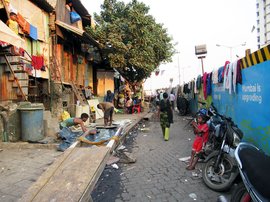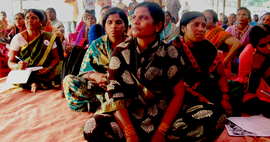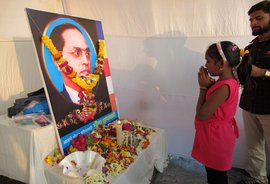“The rain has stopped again,” said Dharma Garel, walking with the support of a bamboo cane towards his farmland. “June has become a strange month. It will rain for 2-3 hours. Sometimes light, sometimes heavy showers. But in the next few hours there will be unbearable heat once more. Absorbing all the moisture of the land. Then the soil becomes dry again. How will the saplings grow?”
Eighty-year-old Garel and his family cultivate paddy on their one acre in Garelpada, an Adivasi hamlet of 15 Warli families in Shahapur taluka of Thane district. In June 2019, the paddy crop they sowed dried up completely. That month, it rained just 393 mm for 11 days (less than even an average of 421.9 mm).
The paddy they had planted didn’t even sprout – and they lost around Rs. 10,000 spent on seeds, fertilisers, a tractor on hire and other cultivation costs.
“It was only in August that the land started cooling down with regular rainfall. I was sure that by risking a second sowing, we would get a harvest, some benefit,” said 38-year-old Raju, Dharma’s son.
After that rain-scarce June, in July, it had rained a lot in the taluka – 1586.8 mm, against the normal rainfall of 947.3 mm. So the Garel family was banking on that second sowing. But by August the rain became much too intense – and it continued till October. All seven talukas of Thane district received excess rainfall of around 1,200 mm in 116 days.
“It was enough rain till September for the growth of the plants. We humans too don’t eat until the belly bursts, why would a small plant?” asks Raju. The October rainfall flooded the Garel family’s farm. “We had started cutting the paddy in the last week of September and stacking it in bundles,” recalls 35-year-old Savita, farmer and Raju’s wife. “We still had to harvest the rest of the crop. After October 5, it suddenly started raining heavily. We tried to take the stacked crops inside the house as much as possible. But within minutes, our farm was flooded…”
From that second sowing of August, the Garels managed to salvage 3 quintals of rice – when in the past they would harvest, from a single sowing, around 8-9 quintals.


Paddy farmers Dharma Garel (left) and his son Raju: 'The rain has not increased or decreased, it is more uneven – and the heat has increased a lot'
“It’s been like this for a decade,” says Dharma. “The rain has not increased or decreased, it is more uneven – and the heat has increased a lot.” In 2018 too, the family harvested just four quintals due to a below-average monsoon. In 2017, another bout of unseasonal rain in October had hit their paddy crop.
Instead, as Dharma observes, the heat seems to have steadily intensified, and become “unbearable”. Data from an interactive portal on climate and global warming of the New York Times shows that in 1960, when Dharma was 20 years old, Thane saw 175 days where temperature could rise to 32 degrees Celsius. Today, that number has increased to 237 days that the temperature can reach 32 degrees.
Across the Adivasi hamlets of Shahapur taluka, several other families speak of falling paddy yields. The district is home to Katkari, Malhar Koli, Ma Thakur, Warli and other Adivasi communities – the Scheduled Tribe population in Thane is roughly 1.15 million (Census 2011), nearly 14 percent of the total.
“Rainfed paddy requires water at regular intervals, which needs proper rainfall distribution. Water stress at any stage of the crop cycle decreases the yield,” says Somnath Choudhury, programme manager at the BAIF Institute for Sustainable Livelihoods and Development, Pune.
Many of the Adivasi families manage to see the year through by growing kharif season paddy on small pieces of land, and then migrating for half the year to work at brick kilns, sugarcane fields and other worksites. But they can no longer count on one half of even this precarious annual rhythm, with the paddy yield repeatedly falling due to an erratic monsoon.Rain fed paddy is cultivated in the kharif season on 136,000 hectares in the district, and on 3,000 hectares of irrigated land (mainly open wells and borewells) during the rabi season (says 2009-10 data of the Central Research Institute for Dryland Agriculture). Some of the other main crops grown here are millets, pulses and groundnuts.

Savita Garel and Raju migrate every year to work in sugarcane fields: 'We don’t get water even to drink, how are we going to give life to our crops?'
Though Thane district has two major rivers, Ulhas and Vaitarna, each with several tributaries, and there are four big dams in Shahapur
taluk
a – Bhatsa, Modak Sagar, Tansa and Upper Vaitarna – farming in the Adivasi hamlets here remains largely dependent on rain.
"The water of all four dams gets supplied to Mumbai. People here face water scarcity from December to May, until the monsoon arrives. So tankers become a major source of water during summer," says Baban Harane, a Shahapur-based social activist and coordinator of the Bhatsa Irrigation Project Rehabilitation Committee.
“There is an increasing demand for borewells in Shahapur,” he adds. “Apart from the digging done by the water department, private contractors illegally dig to more than 700 metres.” The Groundwater Surveys and Development Agency’s Probable Water Scarcity Report, 2018, shows that groundwater has depleted in 41 villages of three talukas of Thane, including Shahapur.
“We don’t get water even to drink, how are we going to give life to our crops? Big farmers manage because they can pay to get water from the dam, or they have wells and pumps,” says Raju.
The water scarcity is one reason why very many from the Adivasi hamlets of Shahapur migrate for work from November to May every year. After the kharif harvest in October, they go to labour at brick kilns in Maharashtra and Gujarat, or to sugarcane fields within the state. They return in time for the kharif sowing season, with barely enough money to meet a few expenses for some months.
Raju and Savita Garel too migrate to Prakasha village in Shahade
taluka
of Nandurbar district, around 500 kilometres away, to work on a sugarcane field. In 2019, they set out a little late, in December, leaving Dharma and their 12-year-old son Ajay back in Garelpada. The family of four had three quintals of rice to survive on until June. “We exchange some rice with the farmers from [nearby] Aghai village who cultivate
tur dal
. This time, it won’t be possible…” Raju had told me, referring to the poor harvest.


Many in Shahapur speak of falling paddy yields. Right: 'The rain is not trustworthy,' says Malu Wagh, with his wife Nakula (left), daughter-in-law Lata and her nieces
He and Savita together earn roughly Rs. 70,000 for their labour of around seven months on the sugarcane fields. Raju also works as a loader at an online shopping warehouse in Bhiwandi
taluka
, around 50 kilometers from Shahapur, between June and September – usually, 50 days of work for Rs. 300 a day.
Around 40 kilometres from Garelpada, in the Bershingipada hamlet, Malu Wagh’s family has also been struggling with falling paddy yields. In one corner of his mud hut with a thatched roof, two quintals of paddy are stored amid neem leaves in a kanagi – a cowdung-bamboo container – to keep away pests. “That’s the most precious thing in the house now,” Malu had told me last November. “We must use our yield carefully because the rain is not trustworthy. It is the king of its own heart, not ours. It doesn’t listen to us.”
Studies too show this is true – the rain has gone rogue. “We have analysed the rainfall data for more than 100 years in Maharashtra,” says Dr. Pulak Guhathakurta, the lead author of a 2013 study done by the India Meteorological Department (IMD). Titled Detecting changes in rainfall pattern and seasonality index vis-à-vis increasing water scarcity in Maharashtra , the study analyses monthly rainfall data for the 1901-2006 period in all 35 districts of the state. “The impact of climate changes on temporal and spatial patterns over smaller spatial scales is clearly noticed in this analysis… These changing patterns are very crucial from the agricultural point of view, especially in farming areas dependent on rain,” adds Dr. Guhathakurta, scientist at the Office of Climate Research and Services, IMD, Pune.
And these changing patterns are having a very real effect on the ground. So when 56-year-old Malu Wagh and his family – from the Katkari community – left for Vapi town in Gujarat’s Valsad district to work at a brick kiln in November 2019 – as did most of the 27 Adivasi families in the hamlet – carrying along 50 kilos of rice, only around two quintals remained in their locked hut, for the months when they will return and stay in Bershingipada – May-June to October.
Around 5 to 10 years ago, we used to harvest 8-10 quintals and [as much as] 4 to 5 quintals of rice used to just lie in my house. Whenever needed, we would exchange some of it with other farmers for tur dal , nagli [ ragi ], warai [millet] and harbhara [chickpea],” says 50-year-old Nakula, Malu’s wife. It would see the family of five through the year. “For more than five years now, we haven’t harvested more than 6 to 7 quintals of paddy.
“The yield is getting lesser every year,” adds Malu.


In one corner of Malu Wagh's hut, paddy is stored amid neem leaves in a kanagi : 'That’s the most precious thing in the house now'
Last year, in August, when the rain started picking up, so did their hopes. But the unseasonal and heavy rainfall of 102 mm in 11 days of October flooded the family’s one-acre farmland. The harvested paddy crop was drenched – only three quintals could be salvaged. “Due to this rainfall,” says Malu, “even the Rs. 10,000 we spent on seeds, fertiliser and hiring bullocks was wasted.”
Most of the 12 Katkari and 15 Malhar Koli families in this hamlet in Shahapur taluka of Thane district shouldered the same loss.
“The monsoon is already known to be highly variable. This variability is further aggravated by climate change, due to which farmers are unable to follow their crop cycles and preferred cropping patterns,” says Prof. D. Parthasarathy, convener, Climate Studies Interdisciplinary Programme at the Indian Institute of Technology, Bombay. A study conducted by him shows that Nashik and Konkan districts of Maharashtra are displaying a significant increase in number of wet spells (rainfall intensity), while in Thane district there is a variation in the number of day (rainfall frequency) of extreme rainfall after 1976-77.
The study focused on the impact of climate change on agriculture, and analysed daily rainfall data collected from 34 districts of Maharashtra for 62 years between 1951 and 2013. “Climate change affects precipitation [rainfall] patterns. Studies show that the beginning of the rainy season and withdrawal of monsoon, wet and dry spells, and total amount of rainfall are all changing with adverse impacts on sowing date, rate of germination, and total yield, sometimes leading to large scale crop failure,” says Prof. Parthasarathy.
In Nehroli village, 124 km from Bersingipada, 60-year-old Indu Agiwale, who belongs to the Ma Thakur community, also speaks of these changing patterns. “We would sow the seeds in Rohini nakshatra [25 May to 7 June]. By the time Pushya [20 July to 2 August] arrived, our crops would be ready for transplanting. Till the Chitra nakshatra [10 October to 23 October] we would start cutting and threshing. Now all this [paddy cultivation process] gets delayed. For long now, the rainfall is not according to the nakshatras . I don’t understand why.”
Indu also speaks of the growing heat. “I have never seen such heat in my whole life. When I was a child, it used to start raining heavily in the Rohini
nakshatra
. It would be continuous rain that cooled down the heated land after summer. The aroma of wet soil would be in the air. Now that aroma has become rare…” she says, while digging holes at the edges to make barricades on her two-acre farmland.

Top row: 'For a long time now, the rainfall is not according to the nakshatras, ' says Indu Agiwale. Botttom row: Kisan Hilam blames hybrid seeds for falling soil fertility
Along with just uneven rainfall, falling yields and rising temperatures, the fertility of the soil in Shahapur is also decreasing, farmers here say. And Kisan Hilam, 68, from Nehroli village, blames hybrid seeds and chemical fertilisers. “
Masuri, chikandar, poshi, dange
…who has these [traditional] seeds now? Nobody. Everyone shifted from traditional to
aushadhwale
[hybrid seeds]. Nobody conserves seeds now…” he says.
When we met, he was mixing a hybrid seed variety in the soil with a pitchfork. “I was against using them. Traditional seeds give less yield but they cope up with the environment. These new seeds cannot even grow without aushadh [fertiliser]. It reduces the purity [fertility] of the soil – regardless of whether the rainfall is poor or heavy.”
“Farmers are becoming increasingly dependent on seed companies rather than preserving stock of their own traditional seeds. But these hybrid seeds, over time, need high amounts of fertilisers, insecticides and water. They can’t give guaranteed yields if these [inputs] aren’t made available. This means that under the changing climate conditions, the hybrids are not sustainable,” explains Sanjay Patil, assistant programme coordinator at BAIF, Institute for Sustainable Livelihoods and Development, Pune. “Now timely and predictable rainfall is rare due to global warming and climate change, so it becomes very necessary to have a staple crop which can adapt to the changing conditions.”
“Traditional rice seeds, used to those locations, are enough to give some output irrespective of the changes in climatic conditions,” adds BIAF’s Somnath Choudhury.
The hybrid seeds also typically require more water, and in rainfed-villages, if the rainfall is uneven, the crops suffer.
Meanwhile, in their makeshift hut at the brick kiln in Vapi earlier this year, Malu, Nakula, their son Rajesh, daughter-in-law Lata, and 10-year-old granddaughter Suvidha, were eating when we spoke on the phone. They had cut down their meals – of rice with some brinjal, potato or sometimes with tomato rassa – to once a day.

Along with uneven rainfall, lower yields and rising temperatures, the fertility of the soil is also decreasing, farmers in Shahapur
taluka say
“Making bricks is not an easy job. Our sweat also gets mixed like water in the mud. So we need to eat properly to continue working. This time, since the yield was less, we are eating just once a day. We cannot finish our [rice] stock before the June sowing season,” Malu said.
At the end of the brick-making season, by May, they usually return to Bershingipada with around Rs. 80,000-90,000 in hand, for the labour of four adults – this must cover their expenses for farming inputs, electricity bills, medicines, and rations such as salt, chilli powder, vegetables, and more for the rest of the year.
Malu Wagh, Dharma Garel and others in the Adivasi hamlets of Shahapur may not know of the term ‘climate change’, but they do know the change itself and daily confront its effects directly. They speak clearly of the many dimensions of climate shifts: erratic rainfall and its uneven distribution; the terrible rise in heat; the rush to borewells and the impact of that on water sources, and as a result, on land, crops and agriculture; the changes in seeds and their effect on yields; worsening food security that climate scientists have so forcefully warned of.
For them, all this is lived experience. Their observations are, in fact, remarkable for how close they are to what the scientists are saying – but in a very different language. And there is that additional battle with the authorities – in these hamlets, that’s usually the forest department.
As Malu puts it: “It is not just rain. We have many battles to fight against. With forest officers [for land titles], with ration officers. Then why would the rain spare us?”
And, standing on his farmland in Garelpada, 80-year-old Dharma says, “The weather has changed. It’s become very hot. The rain does not come on time like it did in the past. If the p raja [people] have not remained as good as in earlier times, then how will nisarg [nature] remain as it was? It is also changing…”
PARI’s nationwide reporting project on climate change is part of a UNDP-supported initiative to capture that phenomenon through the voices and lived experience of ordinary people.
Want to republish this article? Please write to zahra@ruralindiaonline.org with a cc to namita@ruralindiaonline.org




